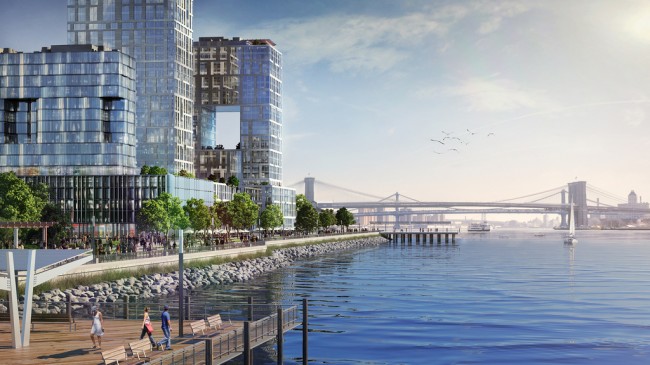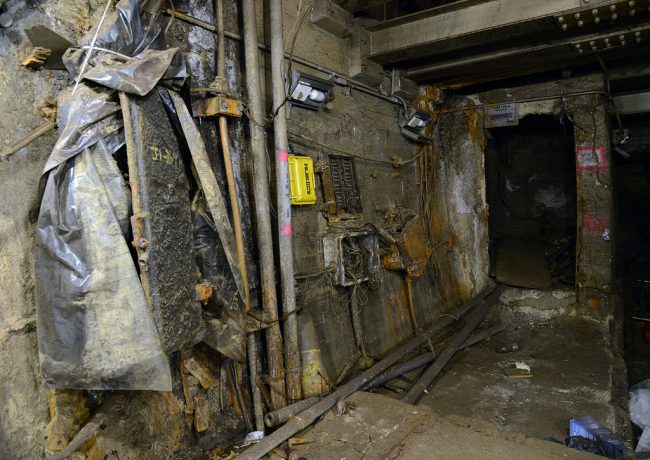
We are celebrating 15 years — and counting — of stories that are deeply researched and deeply felt, that build a historical record of what the city has been.
We are celebrating 15 years — and counting — of stories that are deeply researched and deeply felt, that build a historical record of what the city has been.
As we head into August and the city slows down just a bit, we’ll be taking a brief break from publishing to do some housekeeping and brainstorming and to prepare for a fall line-up of features, special projects, and events. We’ll be back in two weeks!

Seaport City Concept Rendering | Photo courtesy of NYC Mayor’s Office
SEAPORT CITY FORGES AHEAD
When Mayor Bloomberg revealed a $20 billion, 438-page storm protection plan back in June, one aspect of the plan — the construction of Seaport City, an elevated Lower Manhattan neighborhood that would require dozens of acres of landfill — seemed like too ambitious an idea. Nonetheless, this past Wednesday, the City pushed the idea forward by issuing a request for proposals from architects, planners, and developers to begin assessing its feasability, which could leverage future development dollars to finance massive new storm protections.
HOW BUILDINGS KEEP COOL
As summer continues to swelter on, high-profile skyscrapers are keeping cool using a low-tech solution. Rockefeller Center and the Bank of America Tower are among a growing number of buildings using electricity to create ice at night — when power is less expensive — to supplement their air conditioning throughout the day.
NEXT NEW YORK
This week, the Forum for Urban Design released Next New York: A Sketchbook for the Future of the City, a collection of 40 proposals by civic leaders, developers, and designers reimagining infrastructure, government, and the public realm. The sketchbook aims to “provide a platform for our fellows to debate how to create a more livable, competitive, and sustainable city” and encourage further open discussion about the future of New York.
EVERY BODEGA IN MANHATTAN
Visual artist Gail Quagliata has taken it upon herself to photograph every single “corner store” in Manhattan. Believing firmly that these local service providers are an integral part of the built character and identity of the city, she is walking each and every block of the borough to “collect these sites before their owners are driven out of business,” and tracking her progress on a Google map and a blog. Quagliata started her quest in December and only has the bodegas of East and Central Harlem to go. Read more about her motivations in an interview with Jeremiah’s Vanishing New York and check out some more of her images on her website.
FOR AND AGAINST RENT REGULATIONS
Last week, NPR’s “Planet Money” co-founder Adam Davidson examined the positives of eliminating rent regulation in New York City, deeming the system suboptimal as it ties “government support to an apartment unit, not a person,” and in effect makes housing less affordable for those not lucky enough to win a rent-controlled apartment. This week, Gothamist contributor and editor of Tenant/Inquilino Steven Wishnia pushes back, arguing that regulations “protect all tenants from gouging during a chronic housing shortage” and that the current “bifurcated market is largely the result of the weakening of rent stabilization in the 1990s.”

Remaining damage from Hurricane Sandy in the Montague Street Tunnel | Photo via MTA
R TRAIN CHANGES
Starting at 11:30 tonight, the R train tunnel between Manhattan and Brooklyn will be shut down for an estimated 14 months for necessary repairs in the wake of Hurricane Sandy. To cope, the MTA has implemented significant changes including adding a Sunset Park stop on the Rockaway Ferry and rerouting the R train over the Manhattan Bridge on weekends and late nights. Check out WNYC’s R Train Outage Survival Guide before you head out, including this wicked awesome flow chart.
BLOCK BY BLOCK
MapPLUTO — the City’s extensive database of information on buildings and land across the five boroughs — became free and accessible to the public only last week. BKLYNR‘s Thomas Rhiel wasted no time in creating a map showing the age of every building in Brooklyn. The color coded map visualizes the various building booms that created the borough as we know it today.
THE FINAL RECYCLING FRONTIER
New York City’s composting program is expanding, after successful pilot runs in Staten Island and Manhattan, where one high-rise complex saw a 35% drop in trash. Composting will make its way to Brooklyn and the Bronx this fall in both high-rises and residential neighborhoods before expanding to the rest of the outer boroughs next year. The City aims to expand composting to all five boroughs by 2016.
EVENTS and STUFF TO DO
SUMMER STREETS AND VOICE TUNNEL
Summer Streets is back! For three consecutive Saturdays, nearly seven miles of Manhattan streets are blocked to car traffic and given over to pedestrians, bicyclists, mini-golf, a zip-line, rock climbing, and picnic areas from 7am to 1pm. Taking advantage of the closures, pedestrians can wander through the Park Avenue tunnel for the first time since the 1930s. The tunnel will be shut down to car traffic for “Voice Tunnel,” an “incandescent, echoing, interactive art show” designed by Rafael Lozano-Hemmer.
CREATIVE MORNINGS
CreativeMornings is a “free, monthly breakfast lecture for creative types.” Next Friday, Leslie Koch, president of the Trust for Governors Island, will speak on this month’s theme of urbanism on Governors Island. Don’t forget to reserve your ticket on Monday at 11am.
NEWARK RIVERFRONT PARK OPENING
This Saturday, head over to Newark’s Orange Party, a celebration of the opening of the newest segment of the city’s riverfront park. A walk to the waterfront from City Hall will precede the party at 9am, and music, dance, and art will go well into the evening.
EAST VILLAGE MURALS
First Street Green has issued an open call for mural artists to submit design proposals to adorn the plywood walls of First Park, a tiny lot wedged between Houston and 1st Streets, which previously served as the site of the BMW Guggenheim Lab. Submissions are due August 16th.
ELASTIC CITY: UNBINDING THE LIBRARY
Next Tuesday, join our friends at Elastic City for Unbinding the Library, an event to “consider the physical, historical, and ecological relationships between the Reanimation Library and Gowanus — the neighborhood in which the library is situated.” The event is an Elastic City “Way”, one of a series workshops that engage attendees to generate poetic moments in public space. Purchase tickets online here.
The Roundup keeps you up to date with topics we’ve featured and other things we think are worth knowing about.
The views expressed here are those of the authors only and do not reflect the position of The Architectural League of New York.